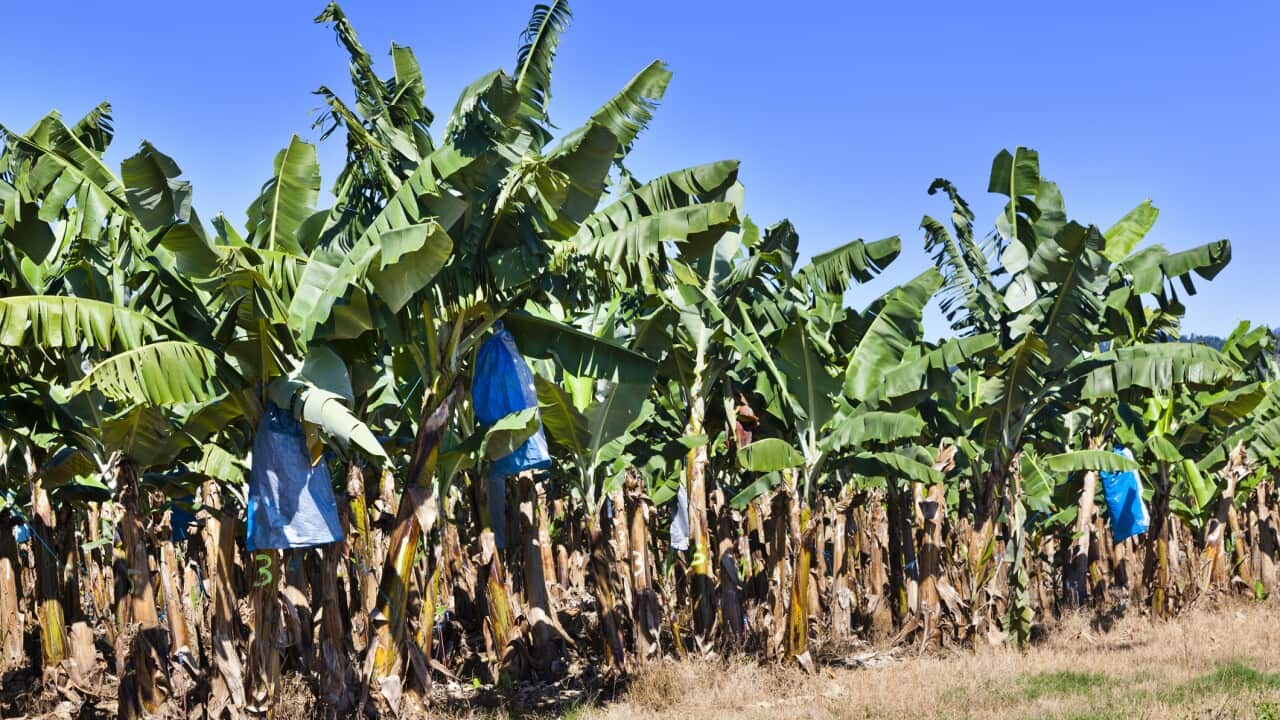The price of bananas and sugar could rise with supplies hit by flooding in North Queensland, the federal treasurer has warned.
The flood-affected areas account for about four per cent of the country’s agricultural production, Jim Chalmers said on Tuesday.
“That means there will be some economic impacts,” he told reporters.
According to initial estimates from Treasury, lost economic activity due to the flooding will reduce GDP in the March quarter by about 0.1 per cent. There may also be upward pressure on prices.
Up to 20 per cent of Australia’s banana crop could be affected by the disaster, Chalmers said, as damage to road networks also hampers supply chains.
Federal Treasurer Jim Chalmers has warned the price of bananas and sugar could rise with supplies hit by the floods in North Queensland. Source: AAP / Lukas Coch
“So you can see that there might be quite narrow but significant impacts on some goods like bananas and sugar, but we don’t expect the overall impact on inflation to be substantial in aggregate,” he said.
The treasurer said the government’s focus remains on the “human cost” of the flooding.
“The danger is still present,” he said.
‘True extent’ of damage not known for weeks
The clean-up is just beginning for flood-stricken growers facing a hard road ahead after weeks of torrential rain.
Sugarcane, avocados, bananas, fishing and livestock have all been hit hard by the wet weather that has plagued north Queensland, claiming two lives.
Rachel Chambers, chief executive of Queensland Fruit & Vegetable Growers, said it will be many weeks until the true extent of the damage is known.
“There is still rain happening in different parts of the region,” she said.
“Growers are still not able to go and assess the damage on their own farm, roads internally have been washed away, there is so much erosion that it almost makes going through the farm impossible — let alone going from farm to farm across local, state and federal road networks.”
Chambers said growers in North Queensland are a “tough bunch” who have moved through successive wet seasons — including, recently, Cyclone Jasper.
“Right now, as you look around, growers are sending us photos of destruction of crops, of stuff that they have picked on trucks — and the trucks haven’t been able to move for six, seven days. They know the fruit on board is rotting and they’re not going to get a return at market,” she said.
“I think that day by day, it will be harder and heavier for growers, because there is such a big clean up.”
A ‘really difficult disaster’
The recent flooding has been a “really difficult disaster” for almost one third of Queensland’s sugarcane growers, Canegrowers chief executive Dan Galligan told SBS News.
He said the impacts have been felt most around Ingham, in the Herbert River Valley region.
“That’s around four million tonnes of cane in that area, most of which has been submerged and is only really is starting to see the light of day today, well after ten days when the rainfall started,” he said.
“It’s certainly a significant impact.”
Flooding is seen in Ingham in North Queensland following days of torrential downpours. Source: AAP / Adam Head
Galligan said sugar cane is a “resilient crop” that can withstand flooding or cyclones. But the real impact on productivity won’t be felt until later in the year when harvesting begins.
He said it is very likely newly-planted cane will have been lost all together, while impacts will also be felt through damage to the local cane railway network.
‘Huge’ economic impact for local community, not Australian consumers
Galligan also said growers are still in the middle of crisis management, and it will at least a week before growers have any idea of the financial impact.
But he said this will be felt by the local community in Queensland, not consumers.
“The reality is, for the Australian consumer, it’s not going to make much difference at all,” he said.
“We export over 85 per cent of the production that we have out of Queensland. Domestic sugar supply doesn’t come out of this region, so the domestic sugar industry shouldn’t have been impacted.”
Despite this, Galligan expects a “huge economic impact”, particularly for the Ingham community.
“Every dollar that has been lost out of a farmer’s pocket because of this flood has an impact,” he said.
More rain has been forecast in the north from Cape York Peninsula, down the tropical coast and into the Burdekin region, with 24 hour totals of up to 200mm before easing on Wednesday.
About 200 trucks have been waiting for days at Townsville for roads to reopen.
But with other road closures like the Macrossan Bridge near Charters Towers, nearly 100 trucks are still waiting to deliver their goods.
Some regions may take some time to recover with at least six Gulf communities cut off by floodwaters.


